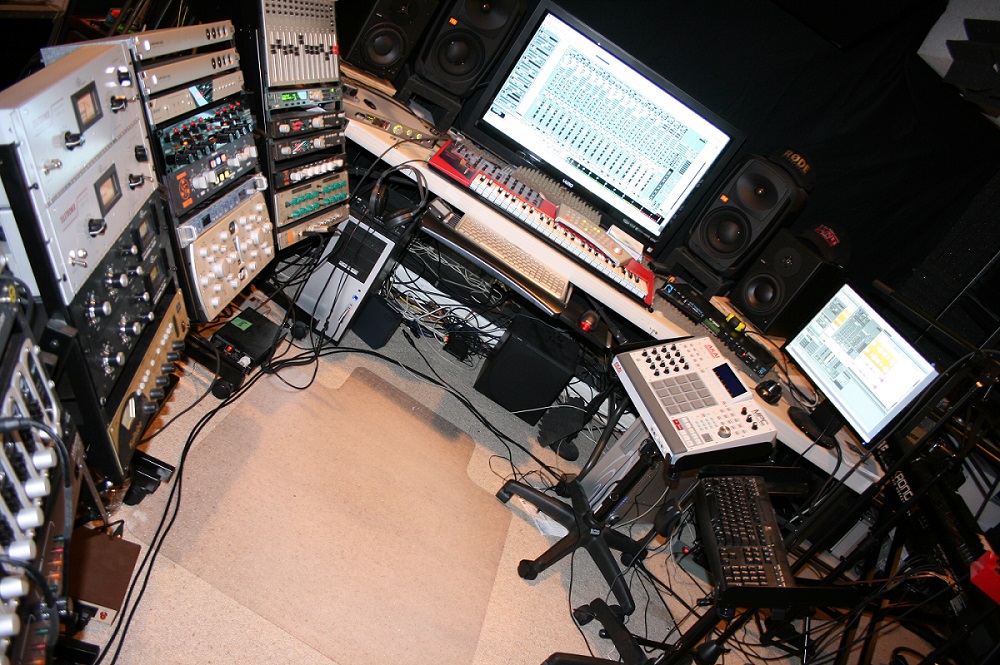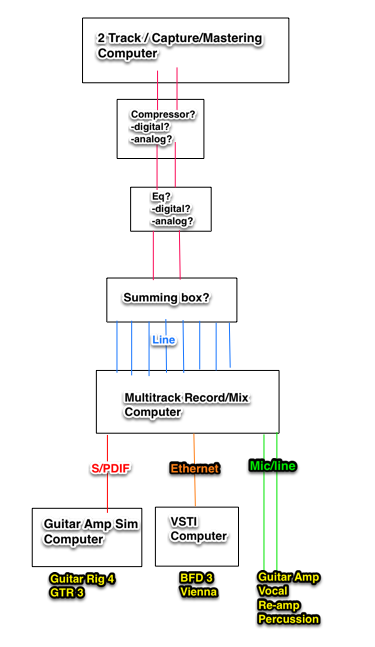Are you interested in hybrid audio. Here is a look into what hybrid mixing, summing and mastering is all about:
This is my most recent hybrid build with some added videos from a few guys explaining the process a bit more.

Being able to include hardware is nothing short of a thrill but I also no longer subscribe to it as the best step to better mixes. I think we will gain a lot more by making sure our room acoustics, methods and gear is up to standards during tracking, over the approach that we can make something sound better (after its been tracked) by passing it through some analog hardware or console. Like everything... hybrid audio has its pro's and con's.
In today's hybrid world, recording, mixing and mastering engineers can add specialized (preferably) big rail consoles that may or may not have fader's or EQ sections. They are more designed for DAW integration to include and/or preserve transparency, add or "direct" "manage" colour or characters to audio, augment sound by means of stem mixing which can include external monitoring, inserting of outboard gear to better route, manage the tasks at hand. Some of these consoles are the Dangerous Master, Liaison, 2Bus, Manley Massive Backbone...and so on.

Comments
Hey guys, I've begun to map out the connections for the studio s
Hey guys, I've begun to map out the connections for the studio setup since the gear list is about 80% decided, 40% purchased. I'm trying to suss out the capture part of the equation. Since some software allows 3+ installs, and others only one, per license, I'm trying to figure out what's the smartest allocation of software purchase and money in general.
As far as hardware goes I'm completely unsure about what to use for a summing section.
As far as technique I have a couple questions:
From summing to capture:
Summing computer.
I'm considering Sequoia or Pro Tools HD purchase in general. Reaper?
I have Samplitude Pro X Suite. So far.
The sample rate thing is important when I'm picking capture converters, Lavry for instance maxes out at 96k.

Here's a diagram of what I have in mind. I've decided on a decoupled/separate amp sim computer to keep latency/response unchanging throughout the whole rec/mix process. The dedicated vsti computer is because BFD and vsl are heavy. Since I've decided to lean on digital amp sims for my live tracking vs just for mixing, it's cheaper and more versatile to have a dedicated computer/interface, than buy a rack unit like fractal axe efx or avid 11. I can take advantage of all the various amp sim plugins out there. The interface allows digital connections for sims that run 192k and analog connections for ones that don't. This allows me to feed the analog amplifiers either via a splitter from the guitar, or the interface out, so I can maintain proper sync/phase between the virtual and analog guitar amps. That way all the signals hit the record daw/converters at the same time both optional ways. I'll make a diagram of this setup soon.
My goal is to have an 'audio only' track format for my tracking/mix daw to keep buffers down and reserve the most processing power for plugins. Ideally this keeps digital bottle-necking to a minimum. Separate instrument CPUs allow me to keep the virtual instruments and amps as close to real-time as possible. The virtual amp buffers should be at a minimum at all times since the computer is only running one sim at a time, and not tracking anything.
I'm slammed right now but once I have some time I will be happy
I'm slammed right now but once I have some time I will be happy to answer these excellent questions.(y)(y)
Cool Chris glad to hear your keeping busy!
Cool Chris glad to hear your keeping busy!
kmetal, post: 440195, member: 37533 wrote: Hey guys, I've begun
Send as many tracks as is appropriate for the mix. These would normally include the "money" tracks (vocals, guitar, solo instruments etc) and sometimes also stereo stem sub-mixes (drum kit, choir etc), but I usually work on the sub-mixes at the analogue mix stage because I want the sound and vibe to sit in with the main mix.
1. This depends on why you are carrying out the mix. If you are creating a 2-track mix to send off to an ME for mastering, then leave out any processing on the captured 2-bus and keep your peaks to a level of -12dBFS (for example). If on the other hand you are generating a rough master for which you need to have final levels, then by all means use a limiter (avoid standard compression) and any 2-bus EQ that an ME would otherwise apply.
2. It doesn't matter how the mix sources arrive, as long as (a) they are all analogue at the point of mixing and (b) they are all latency-compensated so that a click would arrive at the same time instant on all the tracks. On the 2-bus side, use a single stereo A-D converter and then process the captured 2-bus mix in whatever way you want.
3. Again, these can be applied once the 2-bus mix is captured.
1. In principle, yes. The only critical component is the A-D converter. How the output of the converter arrives in a disk file is immaterial as long as there are no dropped samples.
2. Ditto. Any piece of software that guarantees a bit-accurate file copy of the A-D converter output will work. It's one of the reasons I often recommend Audacity for this purpose, as the source code is in the public domain and you can verify that the 24-bit data is unchanged all the way from the A-D converter input to the file storage. This is, of course, provided you apply no EQ or effects on the way. The important point is that you perform a pure capture of the A-D output without any plug-ins running or anything else that could affect the captured samples. You are free to run processing on the 2-bus data once the files have been captured.
3. & 4. No preference, just use the best you have available.
5. See below
6. After you have a 24-bit .bwav file safely on disk.
7. No, it's not necessary. If your capture is of the highest quality you can achieve, use this as the source for all your subsequent derivative versions where compression is involved. However, if all you are mixing for is a 44.1KHz CD, then capture at that rate. A major point of the 2-box process is to capture at the target rate and avoid SRCs.
It's up to you what sample rate you use when capturing the 2-bus mix. The important point is that it's uncoupled from the source sampling rate, even if it's nominally the same rate. If you want (say) a 44.1KHz CD capture and also a 192KHz master, then you simply wire the 2-bus to two concurrent capture systems running at different sample rates. If you have your mix fully automated, then you can run multiple passes of the mix with a single capture system set to different sampling rates for each pass.
This all looks good, but bear in mind the points mentioned above.
Having advocated a pure 2-track capture, there are occasions when I capture 4 or 6 tracks at the 2nd box. These are when I route the analogue 2-bus on to analogue effects or dynamics units, so I capture the dry track as a reference (and for use with subsequent DAW processing) while having the option of employing captured wet tracks.
As someone who has dipped their toe into the world of hybrid / 2
As someone who has dipped their toe into the world of hybrid / 2nd DAW capture recently I am watching and reading this thread with great interest.
Boswell, post: 440205, member: 29034 wrote: Send as many tracks
Good stuff boz I was hoping to hear from you on this. I'm gonna let everything rattle around a bit before reply. Thanks man.
Boswell, post: 440205, member: 29034 wrote: If you are creating
Excellent advice.
Your mix will love you, your ears will love you, and your M.E. will love you, if you keep your LUFS/RMS to around -23 to -18 with peaks at around -12.
Even back when I was mixing to 2 track tape, unless the two track mix down reel was the commercial master, I wasn't printing ridiculously hot.
Yeah, I'd been known to frequently slam some meters on the multi-track deck itself, ( depending on the deck and tape type) and could hit the gain pretty hard on the console, too ( depending on the desk) but when I went for mix-down to the 2 track deck, I was shooting for just enough amplitude to get healthy S to N, and to grab that saturation "sweet spot" (which also depended greatly on the "two" deck I was using, and on the type of tape, too). My mixing method rarely included using any hard limiting between the desk and the two track deck, although sometimes I'd run a mix through one of those pieces - but at unity gain (or just a scoodge less) - to grab the sonic character of that piece.
Of course, if the two track was going to be the press master, I'd insert GR to varying degrees... but not if that tape was headed out to an M.E.
I always liked giving the M.E. room to work, and it was rare that I inserted any hard limiting into the 2 bus for print.
A fact that has been overlooked over time, was that inserting pieces into the console 2-bus - like LA2's, 1176's, Focusrite Reds and other GR pieces into the console - was done to give the producer/client an idea of what the mix would sound like post-mastered. These pieces weren't originally intended to remain active on the 2 bus of the desk during the print to 2 track, if the mix tape was headed out for mastering.
FWIW
DonnyThompson, post: 440216, member: 46114 wrote: A fact that ha
And demoitis was born. Great point D. I'll usually put a light bus comp on once all the elements are in the mix, and mix into it, but it's not usually doing much.
I think my workflow is gonna have to change again w the hybrid system.
Still chewing on boz's post in that reguard.
Hey I was considering the sound devices USB 2 pre as a mixdown c
Hey I was considering the sound devices USB 2 pre as a mixdown converter. Seems like a decent quality unit. At 879$ it's not cheap but not unaffordable. Expensive enough that I have to be very sure. It would also double as the guitar amp sim interface in the mobile rig. And be the primary DAC for the mobile rig.
I've heard my buddies sound devices feild recorder and thought it sounded solid. Nothing bad, nothing flattering.
Any thoughts??
http://www.sounddev…
Hey I was considering
Clever idea. I too have thought about this unit for the very same reason. Whatever you choose for the capture sections, I would look for things that can also be used for high quality remote work.
Example, my capture DAW seconds as my mastering and/or remote rig.
PS, I'm so busy right now but haven't forgotten you in this thre
PS, I'm so busy right now but haven't forgotten you in this thread. I will think of more "my perspective" to add once my summer workflow slows down.
No sweat Chris. It's down to the brand new RME babyface pro, or
No sweat Chris.
It's down to the brand new RME babyface pro, or the 5 years old, but solid, sound devices USB 2 pre 2.
I'm open to anyone's thoughts. Price is close enough to not matter.